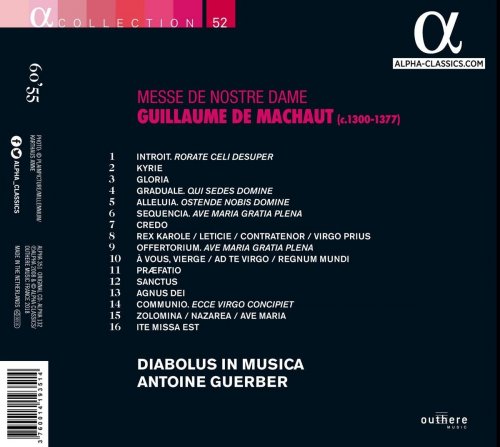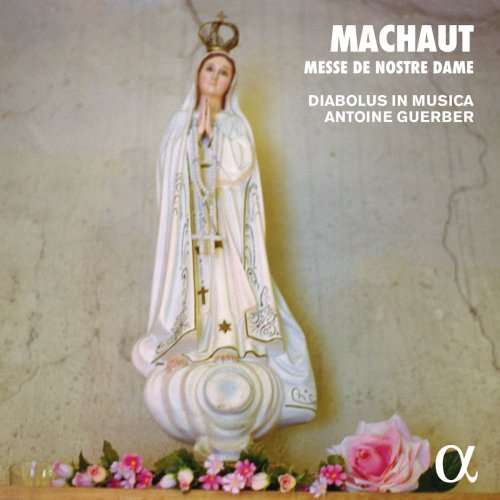
Diabolus in Musica, Antoine Guerber - Machaut: Messe de Nostre Dame (2008)
BAND/ARTIST: Diabolus in Musica, Antoine Guerber
- Title: Machaut: Messe de Nostre Dame
- Year Of Release: 2008
- Label: Alpha
- Genre: Classical
- Quality: flac lossless +Booklet
- Total Time: 01:00:53
- Total Size: 327 mb
- WebSite: Album Preview
Tracklist
01. Messe de Nostre Dame I. Introit. Rorate celi desuper
02. Messe de Nostre Dame II. Kyrie
03. Messe de Nostre Dame III. Gloria
04. Messe de Nostre Dame IV. Graduale. Qui sedes Domine
05. Messe de Nostre Dame V. Alleluia. Ostende nobis Domine
06. Messe de Nostre Dame VI. Sequencia. Ave Maria gratia plena
07. Messe de Nostre Dame VII. Credo
08. Rex Karole - Leticie - Contratenor - Virgo prius
09. Messe de Nostre Dame VIII. Offertorium. Ave Maria gratia plena
10. A vous Vierge - Ad te Virgo - Regnum mundi
11. Messe de Nostre Dame IX. Pr?fatio
12. Messe de Nostre Dame X. Sanctus
13. Messe de Nostre Dame XI. Agnus Dei
14. Messe de Nostre Dame XII. Communio. Ecce virgo concipiet
15. Zolomina - Nazarea - Ave Maria
16. Messe de Nostre Dame XIII. Ite missa est

Guillaume de Machaut was born around 1300 in the environs of Reims, which at that time was a flourishing royal city with a population of almost 20,000, famous throughout Europe for its textile workshops and trade fairs. Like most cathedrals of Western Europe, Reims is built on the site of an earlier edifice. The Rouelle altar, on the left in the nave, adjacent to the choir screen, was dedicated to the Holy Spirit. But in 1343 a magnificent statue of the Virgin Mary was placed there. In 1341 Archbishop Jean de Vienne established a plainchant Votive Mass for the Virgin, to be performed each week before the Rouelle altar. The Marian Mass was introduced by Guillaume de Machaut and his younger brother Jean as a perpetuation of the archbishop’s wish, and it was for that particular liturgy, which was sung every Saturday throughout the year, that Guillaume wrote his famous polyphonic mass. The Messe de Nostre Dame, as it is called in only one of the five surviving manuscripts, is the first complete preserved polyphonic mass known to be by a single hand. It includes the five movements of the Ordinary plus the four-voice Ite missa est. The Mass is not strictly speaking a unified cycle, but there is nevertheless great coherence in its rhythmic and harmonic languages. The succession of movements shows a broad construction and a harmonious and carefully established stylistic progression, from the Kyrie with its strong harmonic structure to the Agnus Dei with its melodic lyricism.
01. Messe de Nostre Dame I. Introit. Rorate celi desuper
02. Messe de Nostre Dame II. Kyrie
03. Messe de Nostre Dame III. Gloria
04. Messe de Nostre Dame IV. Graduale. Qui sedes Domine
05. Messe de Nostre Dame V. Alleluia. Ostende nobis Domine
06. Messe de Nostre Dame VI. Sequencia. Ave Maria gratia plena
07. Messe de Nostre Dame VII. Credo
08. Rex Karole - Leticie - Contratenor - Virgo prius
09. Messe de Nostre Dame VIII. Offertorium. Ave Maria gratia plena
10. A vous Vierge - Ad te Virgo - Regnum mundi
11. Messe de Nostre Dame IX. Pr?fatio
12. Messe de Nostre Dame X. Sanctus
13. Messe de Nostre Dame XI. Agnus Dei
14. Messe de Nostre Dame XII. Communio. Ecce virgo concipiet
15. Zolomina - Nazarea - Ave Maria
16. Messe de Nostre Dame XIII. Ite missa est

Guillaume de Machaut was born around 1300 in the environs of Reims, which at that time was a flourishing royal city with a population of almost 20,000, famous throughout Europe for its textile workshops and trade fairs. Like most cathedrals of Western Europe, Reims is built on the site of an earlier edifice. The Rouelle altar, on the left in the nave, adjacent to the choir screen, was dedicated to the Holy Spirit. But in 1343 a magnificent statue of the Virgin Mary was placed there. In 1341 Archbishop Jean de Vienne established a plainchant Votive Mass for the Virgin, to be performed each week before the Rouelle altar. The Marian Mass was introduced by Guillaume de Machaut and his younger brother Jean as a perpetuation of the archbishop’s wish, and it was for that particular liturgy, which was sung every Saturday throughout the year, that Guillaume wrote his famous polyphonic mass. The Messe de Nostre Dame, as it is called in only one of the five surviving manuscripts, is the first complete preserved polyphonic mass known to be by a single hand. It includes the five movements of the Ordinary plus the four-voice Ite missa est. The Mass is not strictly speaking a unified cycle, but there is nevertheless great coherence in its rhythmic and harmonic languages. The succession of movements shows a broad construction and a harmonious and carefully established stylistic progression, from the Kyrie with its strong harmonic structure to the Agnus Dei with its melodic lyricism.
As a ISRA.CLOUD's PREMIUM member you will have the following benefits:
- Unlimited high speed downloads
- Download directly without waiting time
- Unlimited parallel downloads
- Support for download accelerators
- No advertising
- Resume broken downloads


